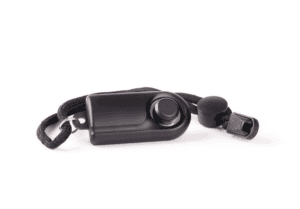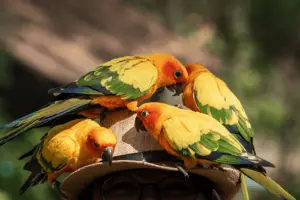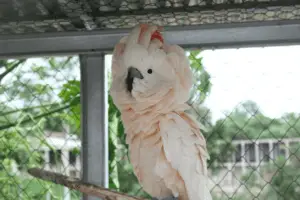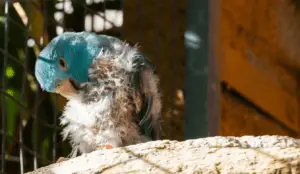Are you breeding budgies for the first time? If yes, you must have many questions running through your mind. For instance, what is it like?
Breeding budgies is a wonderful experience, but there’s much more to know than throwing a pair of parrots in a cage with a nestbox. Let’s journey into the wonders of Budgie breeding, eggs, and incubation. So, you’ll know exactly what you need to sex the eggs, incubate them, care for them, and rear some cute chicks. Let’s get started.
Key Takeaways
- Budgies can lay between 4 to 8 eggs thrice per year.
- Destroy eggs if they don’t hatch by twenty-three days. The eggs can take up to 18 days on average to hatch.
- The budgies can still lay eggs even without a male. But you’ll have to examine them eight days after hatching.
- When candling, you should wait eight days for the blood vessels to be visible.
Budgies are known for laying between 4 to 6 eggs after around 8 to 12 months. If fertile and well incubated, it can take 18 days to hatch. But you must provide the right environment for the budgies to hatch and breed.
Budgies are the most beautiful creatures available in a wide range of colors. These birds do well in pairs, and one of the best ways to increase the number of your parrots is by breeding. So in this article, we’ll show you how to incubate and hatch these eggs. We’ll also show you how long it takes for the eggs to hatch.
How Often Will My Budgies Lay Eggs?
Generally, budgies are known for laying eggs twice or three times per year. They can become an all-year breeder under the right conditions; they’re famous opportunistic breeders. It means that they can breed whenever the environmental conditions are favorable. And Budgies respond well to the wet seasons when the seeds are abundant.
Therefore, you can start breeding them when they turn six months old. So, all you have to do is create this environment for them to start mating; you can even spray some water to make them believe the wet season has arrived. You’ll be surprised by the mating pair feeding and preening each other quickly.
In captivity, they will recognize the change in weather from short and cold days to longer warm days. Therefore, you should manipulate its temperature and the hours exposed to artificial light while increasing the amount of food. Combining these factors can trick them into believing that the conditions favor breeding.
When done correctly and with the right timing, the female can lay 2 to 3 clutches of eggs per year, up to 24 eggs per year. After laying its first egg, this bird will lay an egg after every 1 to 2 days until the clutch reaches a maximum of 8 eggs.
If it’s the first time your budgie is laying eggs, she may not know where to lay them or take care of them. Therefore, you may find these eggs on the floor, so you must provide them with a nesting area.
To protect the eggs, you may have to guide her to the nest by placing some eggs in the egg box. The presence of the eggs will give her an idea of where to lay them.
Even though laying more eggs sounds like a great idea, it is not ideal for your budgie to lay so many eggs within a short period. Too many eggs can cause chronic egg laying, harming your bird’s health. This condition is common among birds but is way more popular among lovebirds, budgies, and cockatiels.
Chronic egg laying is common among pets that lay several clutches of infertile eggs because of lack of a mate. It can result in malnutrition due to calcium depletion from the body, And if you feed it a calcium-deficient diet, your pet may end up with hypocalcemia. Controlling it may result in seizures, egg binding, and even death.
What Do Budgie Eggs Look Like?

If you have different types of parrots in your aviary, you may not know what a budgie’s egg looks like. Therefore you need to learn what each species’ eggs look like for proper breeding. And in our case, the budgie’s eggs tend to be relatively small.
- The budgie eggs can be slightly gray, white, or off-white.
- They’re wide at one end and oval in shape, but some of these eggs are usually circular. Therefore, you shouldn’t be surprised if their forms are not identical; after all, they can come in either shape from the same pair of budgies.
- The average size of these eggs is 2 to 3 cm long and 1 to 2 cm wide.
How Long Can My Budgie Take Before Laying Some Eggs?
Generally, you should expect your budgie to start laying between 8 to 10 days after mating and bonding with the male. After eight days, you’ll notice your pet spending a lot of time in its cage. You’ll also see her looking for calcium-rich foods; these minerals are crucial for healthy egg production.
When ready to lay her first egg, you’ll notice that she spends much of her time in the nest, even at night. Your budgie will also remove unwanted materials and sticks from the resting region. After laying the first egg, it will take her between 24 and 48 hours to produce another egg.
Can A Female Budgie Lay An Egg Without Mating?
The egg-laying process is natural for every bird; our budgies can do it without mating. Unfortunately, these eggs will be unfertilized and can’t hatch. Generally, this happens when you only have female budgies or keep the males and females separate.
A few external factors can influence your budgie to start laying eggs. For example, exposing your pet to sunlight will make its body believe that spring, water, and food are plenty, translating to the best time to raise chicks.
Its body will undergo some hormonal changes that will help its body prepare for laying eggs. The hormonal changes will make the female look for a male; unfortunately, if she doesn’t find one, she’ll just lay an unfertilized egg that would have already formed in its body.
Unlike mammals which can retain sperm from the previous session, budgies need copulation during the egg-developing process. A single copulation is enough to fertilize all the eggs within a week. In some birds, the sperm can remain viable for a week.
If the eggs are unfertilized, the female will still deliver. Unfortunately, young birds new to motherhood will sit on the eggs even when they’re unfertilized and try to incubate them. These eggs won’t be viable and will not hatch; they may rot. Therefore, you must discard the eggs.
What Do I Do With An Unfertilized Egg?
The female bird can spot unfertilized eggs within a few days. And when the female does, these budgies will push the unfertilized eggs out of the nest. If your budgie doesn’t do that, you can take it upon yourself and eliminate the unfertilized eggs.
You can eliminate them as soon as the female delivers; if you don’t do that in time, you can leave your budgie distressed. Taking them away can be distressing to your budgie if she nests and broods over them. They can even become quite aggressive whenever you try to take them away. They can become frantic even after you’ve taken them away.
Just wait for the budgie to lose interest in the eggs or let it realize that they’re infertile. But how would you know the difference between fertilized and unfertilized eggs? You can try candling the eggs to check for fertility.
How Can I Candle The Eggs To Confirm Fertility?
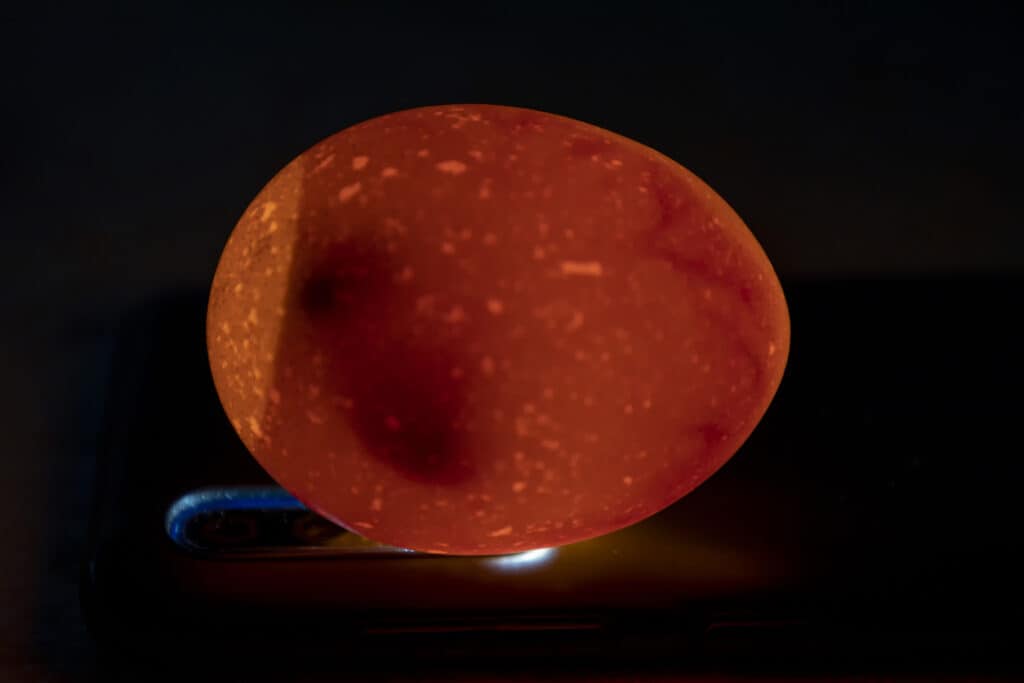
As aforementioned, budgies can lay an unfertilized egg if you keep them away from the male. Unfortunately, these eggs won’t hatch. Luckily, there are many ways to confirm fertility; one of the best ways is by candling. You can candle an egg using a candle, a flashlight, or even your phone’s light.
Start by holding your light source to the egg you are examining until it becomes illuminated. If you can see through it, then the egg is fertilized. A fertilized egg will show a developing embryo or a network of blood vessels. You’ll need a bright light to see the blood vessels, which could be very difficult with dull lighting.
Make sure you use this test if the eggs are from a young budgie or if you discover that your bird has pushed it outside the nest. Otherwise, you don’t want to mishandle the eggs; the best solution is to leave them alone. Fortunately, you don’t even have to move or touch the egg from the nest. You can just look at it from where you are situated.
But if that’s impossible, you can wear gloves and hold them between your thumb and index fingers. This method won’t work on newly laid eggs, so you may have to wait about a week to confirm its viability.
How Long Do Budgies’ Eggs Take To Hatch?
Generally, it takes about 18 days for the fertilized eggs to hatch when the budgie incubates them; therefore, you need to keep track of the budgie using an 18-day chart. With this chart, you can determine when the eggs will hatch. Remember, your pet will start incubating after laying the third egg.
And then, after eighteen days, the eggs will start hatching, but you can give it two more days for all the eggs to hatch. It would be best to avoid the temptation of releasing the chicks from the eggshell. Most beginners try to help the chicks get out of their eggshells, which is not a good idea.
All the unhatched eggs after the twenty-third day have no hope of producing a chick, so you should discard them. l. Worst-case scenario, only 1 out of 4 eggs hatches.
After they have hatched, the female bird will get rid of the eggshells or any other egg that hasn’t hatched. It will help the female bird create more space for the babies.
Why Did the Budgie Eggs Not Hatch?
- The female may have laid unfertilized eggs since there were no males around.
- The male budgie may be infertile.
- The budgie might have neglected the eggs and not brought them to full term.
- A young pair might have been unsuccessful during the mating sessions.
- If you have more parrots in the cage, overcrowding can be an issue as it will leave the bird stressed to incubate her eggs. The other females may also interrupt the incubation process.
- Poor nutrition can also be an issue. For instance, less calcium means soft shells that won’t hatch.
Conclusion
Budgies are exceptional pets that thrive in pairs, which is good if you plan on increasing your budgies by breeding them. The female budgie can lay 4 to 8 eggs per session, and under the right conditions, they can lay eggs up to 3 times yearly. But it’s not always a good idea to make your pet lay 24 years per year as it can result in chronic egg laying.
Budgies are opportunist breeders that love breeding when it’s wet. Therefore, changing temperature, length of exposure to light, and weather conditions can force the bird to start laying eggs again. But if you push the bird to lay eggs again, you must provide more calcium-rich foods and supplements. But most importantly, make sure they mate a few days before she starts laying eggs.
- Wikipedia contributors, Opportunistic breeder,https://en.wikipedia.org/wiki/Opportunistic_breeder/ Accessed March 22, 2023
- Wikipedia contributors, Budgerigar, https://en.wikipedia.org/wiki/Budgerigar#Breeding/ Accessed March 22, 2023
- Wikipedia contributors, Chronic egg laying,https://en.wikipedia.org/wiki/Chronic_egg_laying/ Accessed March 22, 2023
- Paul Ehrlich et al, copulation,https://web.stanford.edu/group/stanfordbirds/text/essays/Copulation.html/ Accessed March 22, 2023
- Petrea Nash, How to candle an egg,https://www.wikihow.com/Candle-an-Egg/ Accessed March 22, 2023



